Animal Diversity: EXAM 3: Tom Holder
1/37
There's no tags or description
Looks like no tags are added yet.
Name | Mastery | Learn | Test | Matching | Spaced |
|---|
No study sessions yet.
38 Terms
Deuterostomes
the 2nd opening becomes the mouth
the blastopore becomes the anus
Protostomes
1st opening becomes the mouth
Phylum Chaetognatha
arrow worms
evolutionary position is still debated
pelagic marine predators
highly specialized for their planktonic existence
horizontal fins bordering the trunk are used in flotation rather than in active swimming
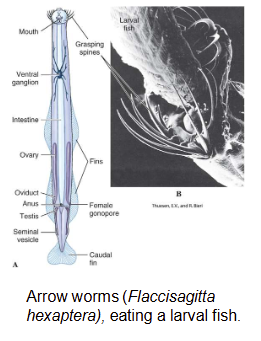
Characteristics of the Phylum Echinodermata
unique water-vascular system
pentaradial symmetry
endoskeleton with spines
digestive system complete
free-swimming bilateral larvae
excretory organs absent
no other group has such complex organ systems and have radial symmetry.
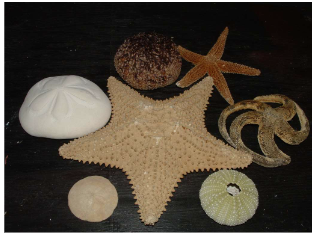
Phylum Echinodermata: evolution/history
likely descended from bilateral ancestors since larvae are bilateral
perhaps evolved radially as an adaptation to sessile existence
found from marine intertidal to abyssal regions
lots of diversity in this group
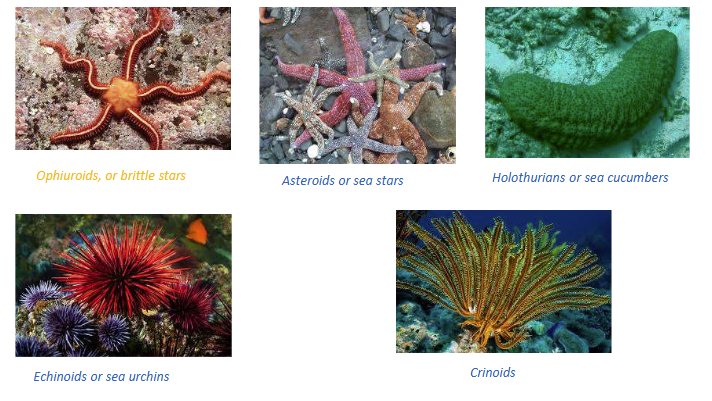
Phylum Echinodermata: Ecological importance
due to spiny structure, they are not often preyed upon
a few fish and sea otters are adapted to feed on sea urchins
sea stars feed on mollusks, crustaceans and other invertebrates
play important ecological role as top predator
sea stars
key stone predator
help maintain increase in species diversity
Phylum Echinodermata: Class Asteroidea
sea stars (commonly known as starfish)
can regenerate lost parts by casting off injured arms and regenerating new ones
about 1,500 living species that range from 1cm to more than 1m across with variable colors and structural features
2 common species: Asterias sp. and pisaster sp.
Phylum Echinodermata: Class Asteroidea: Asterias species
common on the east coast of U.S and often used in school labs
Phylum Echinodermata: Class Asteroidea: pisaster species
common on west coast
keystone predator
Phylum Echinodermata: adaptive diversification
have greatly diversified within the benthic habitat and range from:
creeping forms with filter feeding
scavenging
herbivorous
pelagic, predatory forms
predaceous intertidal
Phylum Hemichordata
Acorn worms and tube worms
formerly considered a subphylum of chordates based on presence of gill slits and rudimentary notochord.
bottom dwellers, living in shallow waters with cosmopolitan distribution but are fragile and secretive
most are sedentary or sessile
Phylum Hemichordata: rudimentary notochord
a buccal diverticulum called stomochord.
NOT homologous to chordate notochord
Phylum Hemichordata: Class Enteropneusta
Acorn worms
sluggish, wormlike creatures that live in burrows in the mud and sand
proboscis is the active part of this animal
it probes its surroundings and collects food in mucous strands.
Phylum Hemichordata: Class Pterobranchia
Tube worms
basic plan of this class is similar to that of enteropneusta with modifications due to sedentary lifestyle
small animals, usually 1 to 7 mm in length
many individuals may live together in collagenous tubes
zooids are not connected but live independently in the tubes and extend their crown of tentacles out through the openings.
Phylum Hemichordata: adaptive diversification
far from bein completely understood
share characters with both echinoderms and chordates
Phylum Hemichordata: similarity with chordates
both have:
pharyngeal slits
chordata is placed as a sister taxon to hemichordates
Phylum Hemichordata: similarity with echinoderms
both:
diffuse epidermal nervous system but dorsal nerve cord in collar region of hemichordates is not diffused
the larva is identical to larva of asteroida
echinoderms are sister groups of hemichordates
Phylum Chordata: Structural plan
name comes from the notochord
all of these have 5 basic characteristics at some point in their life history.
Phylum Chordata: notochord
supporting rod along dorsal axis
Phylum Chordata: 5 basic characteristics
dorsal hollow nerve cord
notochord
pharyngeal gill pouches and slits
an endostyle or thyroid gland
post-anal tail
Phylum Chordata: shared features with other invertebrates
bilateral symmetry
anteroposterior axis
coelom
tube-within-a-tube body plan
metamerism (repetition of body parts)
cephalization (head)
chordates have more structural unity in body plan than many other phyla.
Phylum Chordata: 5 basic characteristics: Dorsal hollow nerve cord
invertebrate → nerve cord → ventral to canal and solid
chordates → single cord → dorsal to canal → tubular
Phylum Chordata: 5 basic characteristics: notochord
extends the length of the body and lies between the gut tract and nervous system
stiffens the body, providing skeletal scaffolding for attachment of swimming muscles
Phylum Chordata: 5 basic characteristics: notochord: in protochordates/jawless vertebrates
the notochord persists throughout life.
Phylum Chordata: 5 basic characteristics: notochord: in vertebrates
the notochord is entirely displaced by vertebrae but persists as intervertebral discs.
Phylum Chordata: 5 basic characteristics: notochord: in vertebrates: intervertebral discs
vertebral column for support
Phylum Chordata: 5 basic characteristics: pharyngeal gill pouches and slits
pharyngeal slits lead from the pharyngeal cavity to the outside
in tetrapods, the pharyngeal pouches give rise to a variety of structures, including the Eustachian tube, middle ear cavity and tonsils.
the perforated pharynx functions as a filter-feeding apparatus in protochordates
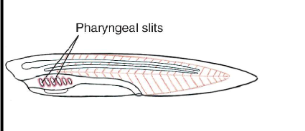
Phylum Chordata: 5 basic characteristics: endostyle or thyroid gland
recently, the endostyle was recognized as a shared chordate character
found in ALL chordates. ONLY
metabolic gland

Phylum Chordata: 5 basic characteristics: post-anal tail
provides motility for larval tunicates and amphioxus to swim.
musculature → invertebrate groups
this was increased in fishes but became smaller or vestigial in later lineages
ex: human: coccyx
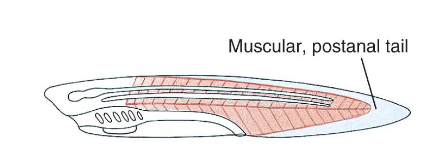
Phylum Chordata: Ancestry and Evolution
the deuterostomes (2 openings) are a natural grouping that has a common origin in Precambrian seas
arose about 570 MYA
from a lineage related to echinoderms and hemichordates
molecular data suggest that a clade containing both echinoderms and hemichordates is the sister group of chordates
Phylum Chordata: Subphylum Urochordata
invertebrates
tail chordates but commonly known as tunicates
about 1,600 species of tunicates.
all salt water/marine
most are sessile as adults
Tunic
a tough, non living tissue containing cellulose that surrounds tunicates
only the larval form bears all the cordate hallmarks but adults retain the notochord only in the tail region
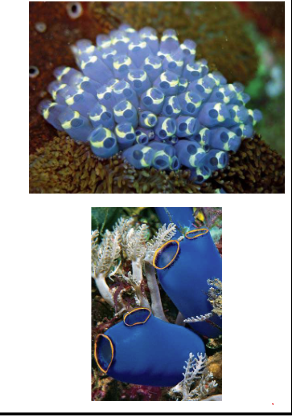
Phylum Chordata: Subphylum Urochordata: Class Ascidiacea
sea squirts
have hearts that drives blood first in 1 direction for a few beats and then reverses direction
Phylum Chordata: Subphylum Cephalochordata
lancelets
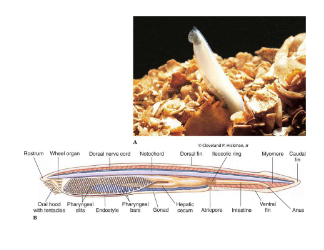
Phylum Chordata: Subphylum Vertebrata: adaptations and evolution
vertebrates
has series of vertebral elements making up the vertebral column
earliest vertebrates were substantially larger than protochordates and considerably more active
modification of skeletal structures and muscles increased speed and mobility.
higher activity level and size of vertebrates required structures specialized in the location, capture, and digestion to support a high metabolic rate
predation: increased mouth size/ JAWS
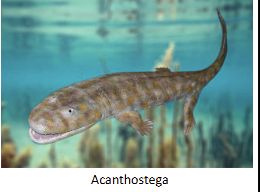
Phylum Chordata: Subphylum Vertebrata: structure
musculoskeletal modification occurred in most vertebrates that passes both an exoskeleton and endoskeleton made of cartilage or bone
*endoskeleton permits almost unlimited body size.
vertebrates have disc-like centra that replaced the notochord and neural spines provide more area for attachment of segmented muscles.
segmented body muscles (myomeres) changed from v-shaped muscles of ancestral chordates to w-shaped muscles of vertebrates which allowed for powerful control over body
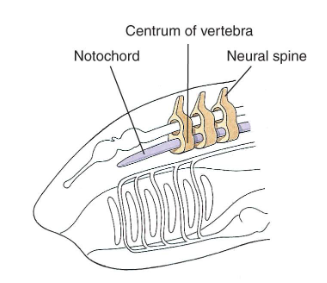
Phylum Chordata: Subphylum Vertebrata: endoskeleton
composed initially of cartilage and later of bone
cartilage grows faster and is more flexible than bone which is an ideal first framework
endoskeleton of living hagfishes, lampreys, sharks, and their kin, and even some “bony” fishes, like sturgeons, composed of cartilage.
*bone formation may have been adaptive for early vertebrates.
structural strength of bone is SUPERIOR to cartilage
this makes bone more ideal for muscle attachment in areas in high mechanical stress.
Phylum Chordata: Subphylum Vertebrata: modifications
bone may have also evolved as (30)